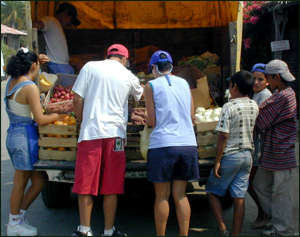 What advice would you give women in setting up their galleys, in preparing to cook aboard ? What advice would you give women in setting up their galleys, in preparing to cook aboard ?
My primary advice to women preparing to cook aboard is to do what you know. Aside from some resource considerations (water, power, refrigeration etc)
that vary from boat to boat, I find that keeping things familiar makes for
an easy transition.
To whatever extent possible, bring the tools you use
every day, and I say "tools" because it is a great argument for space with
the one who controls the boat "tools"! Plan your galley for the way you
like to cook, and eat what you normally enjoy eating. One of my favorite
sayings is "if you don't like spam at home, you won't like it on the boat".
Cooking is my passion and hobby, in addition to being a necessary part of
living aboard, and the captain and I spent time planning how it would be
both functional and satisfy my creative needs. Just as someone with a photo
or jewelry hobby needs a space and tools to conduct their activities, so
does the passionate cook!
We planned the size and configuration of the
refrigeration, and Dennis built in a lift up counter for additional counter
space. He also built me a lift up step, to help me (since I am short) to
get into the far reaches of cabinets and the frig. If you have the luxury
of a handy captain, take advantage of it to customize your galley.
Set up an organization plan for your food lockers. I started out by setting
up a spreadsheet to inventory and locate food items, but found that I didn't
keep it current, and it fell by the wayside. The more successful method for
me, and the one I use now, is to divide the lockers by categories. First, I
have short term and long term storage. Things I use frequently are closer
to the galley, and the long term stores are in the bigger, less accessible,
more distant bins. Then beyond that division, I have separate lockers for
canned goods, grains and staples, baking, snacks and appetizers, condiments
and specialty items. That works for me, but you know what works best for
you. Rubbermaid plastic coated shelving and plastic baskets are very useful
for dividing storage areas in large compartments.
Lastly, I'm a great believer in the "2 uses" rule. All those wonderful
gadgets we have in our land kitchen are really handy, but if it doesn't do
at least 2 things, it doesn't go in my galley, with the possible exception
of my pineapple corer - and I'm still looking for another use for that. |
